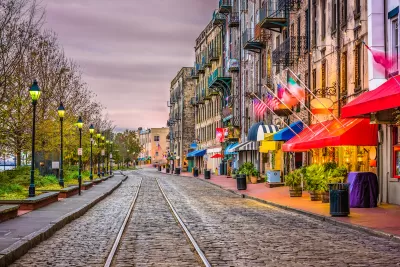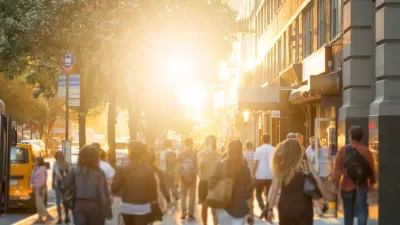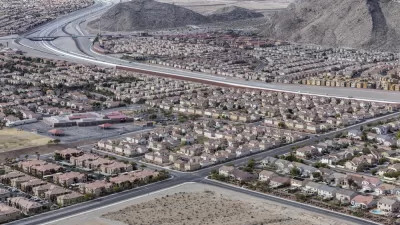From a human-scales, plaza-anchored grid to suburban sprawl, the oldest planned city in the United States has seen wildly different development patterns.

In a piece for Strong Towns, Edward Erfurt describes some lessons for urbanists drawn from the oldest planned city in the United States, Savannah, Georgia.
As Erfurt explains, “Savannah’s streets and blocks are organized around a series of squares” that divide parcels for private development. In the mid-20th century, urban renewal led to the destruction of older communities in favor of larger developments, eliminating some of the city’s historic walkability and human-scaled spaces.
As a result of these rapid and destructive changes, Erfurt argues, “Savannah is a city stuck in regulatory amber. All of the dramatic and radical change the city has experienced has hardened the position of residents to reject change.”
For Erfurt, Savannah is a great example of a city with “the full extremes” on the development spectrum, with historic areas revealing small-scale development patterns and sprawling suburbs. But modern mistakes shouldn’t freeze development in place, Erfurt writes. “Cities that are not exempt from change allow for the natural pattern of development to begin while restricting radical change. Allowing for small incremental changes, at scale, dispersed throughout the city, will thicken the historic grid of the city and continue Savannah’s success into the next 300 years.”
FULL STORY: Lessons on Development Patterns From America’s Oldest Planned City

Planetizen Federal Action Tracker
A weekly monitor of how Trump’s orders and actions are impacting planners and planning in America.

Congressman Proposes Bill to Rename DC Metro “Trump Train”
The Make Autorail Great Again Act would withhold federal funding to the system until the Washington Metropolitan Area Transit Authority (WMATA), rebrands as the Washington Metropolitan Authority for Greater Access (WMAGA).

The Simple Legislative Tool Transforming Vacant Downtowns
In California, Michigan and Georgia, an easy win is bringing dollars — and delight — back to city centers.

The States Losing Rural Delivery Rooms at an Alarming Pace
In some states, as few as 9% of rural hospitals still deliver babies. As a result, rising pre-term births, no adequate pre-term care and "harrowing" close calls are a growing reality.

The Small South Asian Republic Going all in on EVs
Thanks to one simple policy change less than five years ago, 65% of new cars in this Himalayan country are now electric.

DC Backpedals on Bike Lane Protection, Swaps Barriers for Paint
Citing aesthetic concerns, the city is removing the concrete barriers and flexposts that once separated Arizona Avenue cyclists from motor vehicles.
Urban Design for Planners 1: Software Tools
This six-course series explores essential urban design concepts using open source software and equips planners with the tools they need to participate fully in the urban design process.
Planning for Universal Design
Learn the tools for implementing Universal Design in planning regulations.
Smith Gee Studio
City of Charlotte
City of Camden Redevelopment Agency
City of Astoria
Transportation Research & Education Center (TREC) at Portland State University
US High Speed Rail Association
City of Camden Redevelopment Agency
Municipality of Princeton (NJ)





























